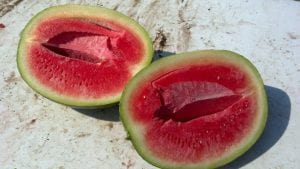Gordon Johnson, Extension Vegetable & Fruit Specialist; gcjohn@udel.edu
Successful fruit set and development in triploid watermelons consists of eight phases: 1) flowering of triploids (seedless) and diploid (seeded) pollenizers, 2) pollen production by seeded pollenizers, 3) pollen transfer from male pollenizer flowers to female flowers on the seedless plants by bees, 4) pollen germination and pollen tube growth in the female flower, 5) a fertilization-like event (in the seedless ovary, the pollen tubes grow to the ovule but fertilization cannot proceed normally because chromosome numbers do not match), 6) hormones are released – auxin, gibberellins 7) cells in the fruit divide to give the potential fruit size, and 8) cells expand and fruit enlarges as sugars accumulate. Photosynthate (sugar) production and movement to developing fruits is critical in the cell division and cell expansion stages.
I have developed a theory that a reduction in the amount of pollen that germinates and successfully produces pollen tubes will cause reduction in hormones released during the fertilization-like event and limit initial cell division leading to increased hollow heart. Experiments I have conducted at the University of Delaware in Georgetown have shown that limiting pollen increases hollow heart in triploid watermelons.
Two studies were conducted in triploid watermelons in 2010 to gather preliminary information on conditions affecting hollow heart disorder. In the first study, test beds were planted to Liberty triploid watermelon, a variety known to have had significant hollow heart in Delaware production fields in the past. Plants were transplanted with no diploid pollenizers. These test beds were separated by beds that were planted in normal fashion with seedless varieties at 3 feet apart and a diploid pollenizer plant placed between every third and fourth plant in the bed, thus creating varying distances from a pollen source in test beds. In the second study, seedless varieties were transplanted at increasing distances from a pollen source. At maturity, watermelon fruits from test plots were split and hollow heart incidence, length and diameter of hollow heart, melon diameter and length, distance from seedless mother plant crown, distance from nearest pollenizer crown, distance from nearest pollenizer plant, and node of attachment were recorded. Seedless fruit in the adjacent beds were also split to record hollow heart incidence only.
There was no hollow heart in the beds with normal pollenizer spacing. There was a large increase in hollow heart frequency as triploid fruits approached and exceeded a 6 foot distance from a pollenizer crown. Past 8 feet, and where the pollinizer to seedless ratio exceeded 1:5, hollow heart incidence was increased to 74%. There were no differences in hollow heart by weight class; however, highest hollow heart frequency was found with a length to width ratio of 1.26 suggesting that longer watermelons may be more susceptible to hollow heart.
Experiments were conducted from 2011-2013 where pollenizers were spaced at a 1:10 ratio with selected triploids. In 2011 there was increased hollow heart incidence in triploid seedless fruits starting 6 feet from a pollenizer crown: at 6 feet hollow heart was 12%; at 14 feet, 28%. In a 2012 study, there was delayed fruit set and increased hollow heart with increasing distance from pollenizer plants. This relationship was linear in the cultivar ‘Liberty’ but not in the cultivar ‘SS7187’. In 2013, it was shown that under pollen limited conditions, less dense fleshed varieties (Liberty, SS7187) had 312-432% more hollow heart than more dense fleshed watermelon varieties (Crunchy Red and AC9651).
Hand pollination studies in 2011 and 2013 showed reduced hollow heart with increased amounts of pollen. Pollen transfer studies showed that ~500 pollen grains are necessary for triploid watermelon fruit set but ~1000 pollen grains were necessary for full fruit size and reduced hollow heart incidence. Growth regulator studies from 2011-2013 showed that auxin (2,4-D, IBA) and cytokinin (6BA, CPPU) applications improved early fruit set.
The theory that inadequate pollination increases hollow heart incidence and severity therefore has considerable evidence, however the effect differs significantly with variety.
Recommended management to reduce hollow heart includes insuring adequate pollen availability with matched pollinizer/triploid selection, use of mixed pollenizers with different flowering peaks, planting extra pollenizers, maintaining vigor of vines and planting to avoid cold weather at pollination. To improve pollen transfer, place extra bees, place hives in several locations around or in the field, consider using bumblebees for plantings where flowering occurs in colder weather, time bee placement properly, and manage pesticides to reduce effects on bees.
A triploid (seedless) watermelon with hollow heart.

